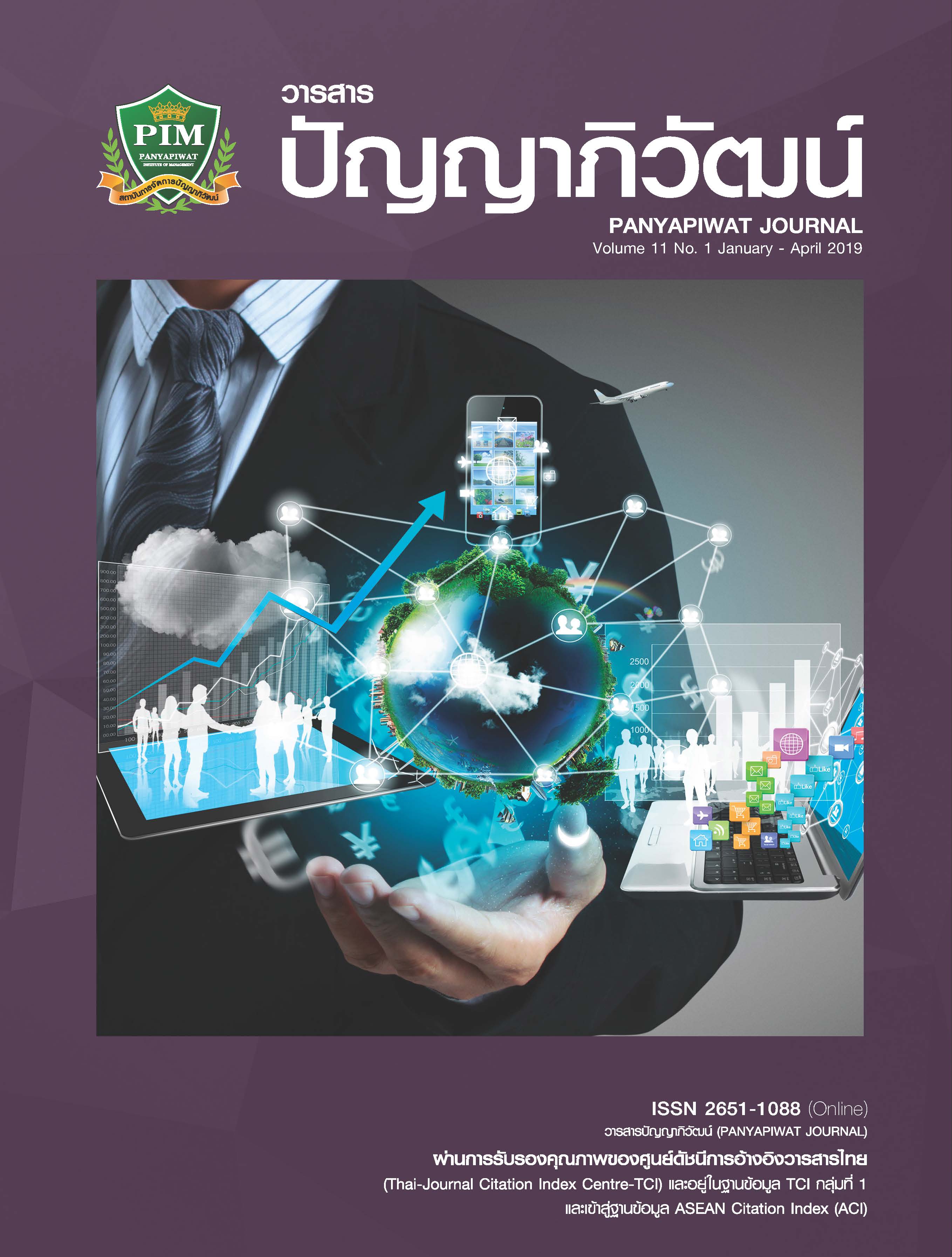องค์ประกอบของผลิตภัณฑ์และคุณค่าตราสินค้าที่มีผลต่อความภักดีในตราสินค้าของผลิตภัณฑ์บำรุงผิวหน้าในเขตพื้นที่จังหวัดชลบุรี
Main Article Content
บทคัดย่อ
การศึกษาวิจัยครั้งนี้มีวัตถุประสงค์เพื่อศึกษาองค์ประกอบของผลิตภัณฑ์และคุณค่าตราสินค้าที่มีผลต่อความภักดีในตราสินค้าของผลิตภัณฑ์บำรุงผิวหน้าในเขตพื้นที่จังหวัดชลบุรี กลุ่มตัวอย่างคือ ผู้ใช้ผลิตภัณฑ์บำรุงผิวหน้าในจังหวัดชลบุรี จำนวน 400 ตัวอย่าง เก็บแบบสอบถามโดยวิธีการสุ่มตัวอย่างเลือกแบบตามสะดวก สถิติที่ใช้ในการ
วิเคราะห์ข้อมูลคือ สถิติเชิงพรรณนา ได้แก่ ความถี่ ร้อยละ ค่าเฉลี่ย และส่วนเบี่ยงเบนมาตรฐาน สถิติเชิงอนุมาน ได้แก่ การวิเคราะห์ความถดถอยพหุคูณ ลักษณะของแบบสอบถามเป็นคำถามเกี่ยวกับองค์ประกอบของผลิตภัณฑ์คุณค่าตราสินค้า และความภักดีในตราสินค้า โดยผู้ตอบแบบสอบถามส่วนใหญ่เป็นเพศหญิง มีอายุต่ำกว่า 26 ปี
จบการศึกษาระดับปริญญาตรี ประกอบอาชีพพนักงานเอกชน/รัฐวิสาหกิจ รายได้ต่อเดือน 10,001-30,000 บาท
ผลการวิจัยพบว่า องค์ประกอบของผลิตภัณฑ์ที่มีผลต่อความภักดีในตราสินค้าของผลิตภัณฑ์บำรุงผิวหน้าในเขตพื้นที่จังหวัดชลบุรี ได้แก่ ด้านผลิตภัณฑ์หลัก ด้านรูปลักษณ์ผลิตภัณฑ์ และด้านศักยภาพของผลิตภัณฑ์มีผลต่อความภักดีในตราสินค้าของผลิตภัณฑ์บำรุงผิวหน้าในเขตพื้นที่จังหวัดชลบุรี อย่างมีนัยสำคัญทางสถิติที่ระดับ 0.05
มีความสัมพันธ์กันในระดับปานกลาง (R = 0.425) ในขณะที่คุณค่าตราสินค้าที่มีผลต่อความภักดีในตราสินค้าของผลิตภัณฑ์บำรุงผิวหน้าในเขตพื้นที่จังหวัดชลบุรี โดยด้านการคิดพิจารณาตราสินค้า และด้านเสียงสะท้อนจากตราสินค้ามีผลต่อความภักดีในตราสินค้าของผลิตภัณฑ์บำรุงผิวหน้าในเขตพื้นที่จังหวัดชลบุรี อย่างมีนัยสำคัญทางสถิติที่ระดับ
0.05 มีความสัมพันธ์กันในระดับมาก (R = 0.612)
Article Details
“ข้าพเจ้าและผู้เขียนร่วม (ถ้ามี) ขอรับรองว่า บทความที่เสนอมานี้ยังไม่เคยได้รับการตีพิมพ์และไม่ได้อยู่ระหว่างกระบวนการพิจารณาลงตีพิมพ์ในวารสารหรือแหล่งเผยแพร่อื่นใด ข้าพเจ้าและผู้เขียนร่วมยอมรับหลักเกณฑ์การพิจารณาต้นฉบับ ทั้งยินยอมให้กองบรรณาธิการมีสิทธิ์พิจารณาและตรวจแก้ต้นฉบับได้ตามที่เห็นสมควร พร้อมนี้ขอมอบลิขสิทธิ์บทความที่ได้รับการตีพิมพ์ให้แก่สถาบันการจัดการปัญญาภิวัฒน์หากมีการฟ้องร้องเรื่องการละเมิดลิขสิทธิ์เกี่ยวกับภาพ กราฟ ข้อความส่วนใดส่วนหนึ่งและ/หรือข้อคิดเห็นที่ปรากฏในบทความข้าพเจ้าและผู้เขียนร่วมยินยอมรับผิดชอบแต่เพียงฝ่ายเดียว”
References
Assael, H. (1998). Consumer behavior and marketing action (6th ed.). Cincinnati, OH: South Western College.
Cochran, W. G. (1977). Sampling techniques (3rd ed.). New York: John Wilay & Sons.
Dhammasondhi, S. (2006). Factor Affecting the Facial Care Product Consumption of Consumers in Chiang Mai Province. M.B.A., Chiang Mai University. [in Thai]
Hirankitti, P. (2005). Industrial product marketing. Bangkok: Dharmasarn Printing. [in Thai]
Kandampully, J. & Suhartanto, D. (2002). Customer loyalty in the hotel industry: The role of customer satisfaction and image. International Journal of Contemporary Hospitality Management, 12(6), 346-351.
Keller, K. L. (2003). Strategic brand management: Building, measuring, and managing brand equity (2th ed.). Upper Saddle River: Prentice Hall.
Kotler, P. & Keller, K. (2009). Marketing management (13th ed.). New York: Prentice Hall.
Kotler, P. (2003). A framework for marketing management (2nd ed.). New Jersey: Pearson Education.
Marketingoops. (2017). The beauty universe 150 billion. Retrieved March 6, 2018, from https://www.marketingoops.com/reports/fast-fact-reports/beauty-industry-thailand-2016/ [in Thai]
Musika, K. (2013). The Composition of the Produce and Consumer based Brand Equity effect to Attitude of Cosmetic Thai Brand in Laos People’s Democratic Republic. Journal of Graduate School of Commerce-Burapha Review, 8(2), 107-116. [in Thai]
National Council for Peace and Order. (2017). The eastern economic corridor development project. Retrieved July 22, 2018, from https://library2.parliament.go.th/giventake/content_ncpo/ncpo-head-order2-2560.pdf [in Thai]
Poonyarith, J. (2017). Marketing mix and brand equity affecting the distributor’s buying decisions of AGELOC products at nu skin enterprises (Thailand) limited in Bangkok. Graduate School, Bangkok University. [in Thai]
Schiffman, L. G. & Kanuk, L. L. (1994). Consumer behavior (5th ed.). Englewood Cliffs, NJ: Prentice-Hall.
Sudsawatt, J. (2012). Factors of marketing mix and brand equity that have an effect on how the Bangkok University’s college student decide to buy the Korea cosmetics. Graduate School, Bangkok University. [in Thai]
Vanichbuncha, K. (2002). SPSS for Windows (6th ed.). Bangkok: Statistics, Commerce and Accountancy, Chulalongkorn University. [in Thai]

